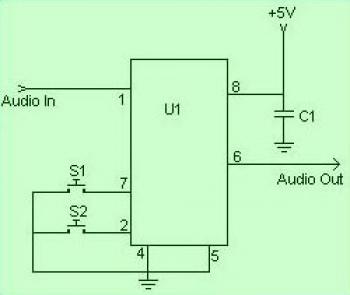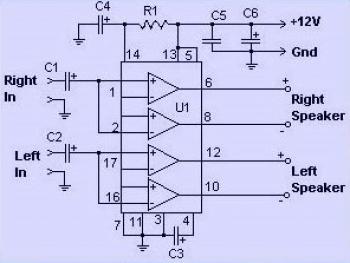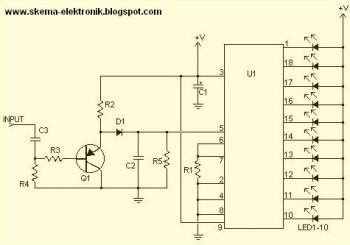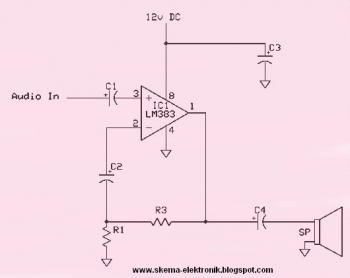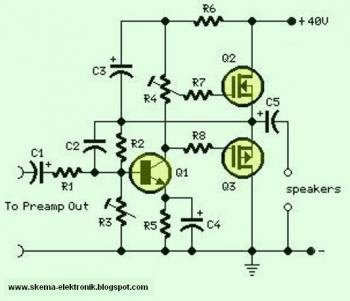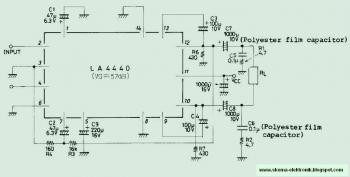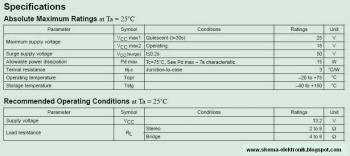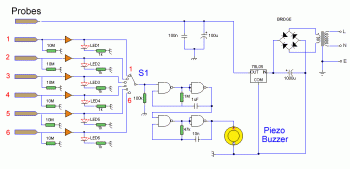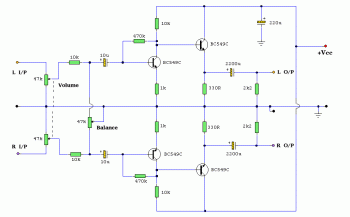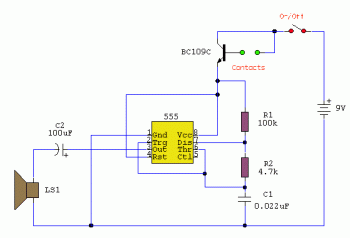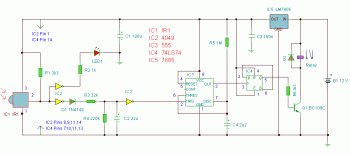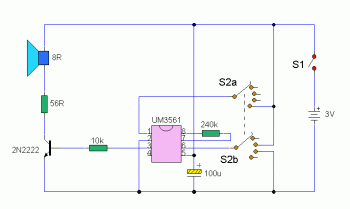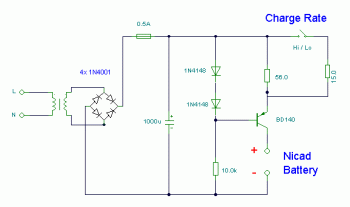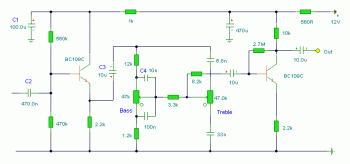Digital Volume Controller
22 Watt Stereo Audio Amplifier
Component List:
| R1 C1,C2 C3 C4 C5 C6 U1 MISC | 39K 1/4 Watt Resistor 10uf 25V Electrolytic Capacitor 100uf 25V Electrolytic Capacitor 47uf 25V Electrolytic Capacitor 0.1uf 25V Ceramic Capacitor 2200uf 25V Electrolytic Capacitor TDA1554 Two Channel Audio Amp Chip Heatsink For U1, Binding Posts (For Output), RCA Jacks (For Input) |
10 LED Sound Level Meter
Supply voltage can be from 3V to 20V. The input is set for audio line voltage (1V peak to peak) and has a max input voltage of 1.3V. To make the circuit use a moving dot display instead of bar graph display, Pin 9 can be should be disconnected from +V.
Parts List.
| C1 C2, C3 R1, R3 R2 R4 R5 D1 Q1 LED1-LED10 U1 MISC | 2.2uF 25V Electrolytic Capacitor 0.1uF Ceramic Disc Capacitor 1K 1/4W Resistor 10K 1/4W Resistor 100K 1/4W Resistor 1M 1/4W Resistor 1N4001 Silicon Diode BC 558 PNP Transistor Standard LED or LED Array LM3915 Audio Level IC Board, Wire, Socket For U1 |
8 Watt Audio Amplifier
Component List:
C1 - 10uf Electrolytic Capacitor
C2 - 470uf Electrolytic Capacitor
C3 - 0.1uF Disc Capacitor
C4 - 2000uf Electrolytic Capacitor 2200uF
R1 - 2.2 Ohm Resistance (Anything Within 10% tolerance)
R3 - 220 Ohm Resistance (Anything Within 10% tolerance)
IC1 - LM383 IC
18 watt Audio Amplifier using MOSFET
Components list:
R1………………2K2 1/4W Resistance
R2………………27K 1/4W Resistance
R3R4………….2K2 1/2W Trimmers
R5………………100R 1/4W Resistance
R6………………1K 1/4W Resistance
R7,R8……….. .330R 1/4W Resistance
C1 ………………22µF 25V Electrolytic Capacitance
C2 ………………47pF 63V Polyester or Ceramic Capacitance
C3,C4 …………100µF 50V Electrolytic Capacitance
C5 ………………2200µF 50V Electrolytic Capacitance
Q1 ………………BC550C
Q2 ………………IRF530 or MTP12N10
Q3……………… IRF9530 or MTP12P10
Headphone Stereo Amplifier
Water Activated Alarm
An On/Off switch is provided and remember to use a non-reactive metal for the probe contacts. Gold or silver plated contacts from an old relay may be used, however a cheap alternative is to wire alternate copper strips from a piece of veroboard. These will eventually oxidize over but as very little current is flowing in the base circuit, the higher impedance caused by oxidization is not important. No base resistor is necessary as the transistor is in emitter follower, current limit being the impedance at the emitter (the oscillator circuit).
Infrared Switch
This is a single channel (on / off) universal switch that may be used with any Infra Red remote control using 36-38kHz. (This is a very common remote handset frequency). In place of IR1 a TSOP1738 receiver may be used.
Any "button" of any remote control may be used to work this universal switch. The button must be pressed for about one and a half seconds (determined by R3 and C2) before the relay will operate. The circuit will remain in this state (latched) until reset. To reset, any button is pressed on the remote handset and held for a short duration.
For example, if you were watching TV, you could press and hold any button on the TV remote to trigger the circuit. In order not to change channel, you could press the button of the channel you are watching. You can connect anything to the relay, for example a lamp, but make sure that the relay contacts can handle the rated voltage and current.
Sound Effects Alarm Generator
This schematic in very simple and easy to made. The IC produces all the sound effects, the output at Pin 3 being amplified by the transistor. A 64 ohm loudspeaker can be substituted in place of the 56 ohm resistor and 8 ohm loudspeaker. The 2 pole 4 way switch controls the sound effects. Position 1 (as drawn) being a Police siren, position 2 is a fire engine sound, 3 is an ambulance and position 4 is a machine gun effect. The IC is manufactured by UMC and was available from Maplin electronics code UJ45Y. At the time of writing this has now been discontinued, but they have have limited stocks available.
NiCad Battery Charger
This simple and low cost battery charger uses a single transistor as a constant current source. The voltage across the pair of 1N4148 diodes biases the base of the BD140 medium power transistor. The base-emitter voltage of the transistor and the forward voltage drop across the diodes are relatively stable. The charging current is approximately 15mA or 45mA with the switch closed. This suits most 1.5V and 9V rechargeable batteries.
The transformer should have a secondary rating of 12V ac at 0.5amp
Low Cost Tone Control Circuit
This cheap tone control circuit provides a maximum cut and boost of around 10dB at 10K and 50Hz. Two potensiometer used to control the high frequency (treble) and low frequency (bass).
The first BC109C transistor (left hand side) is acting as a buffer. It provides the circuit with a high input impedance, around 250k has a voltage gain of slightly less than unity. As the Baxendall tone control circuit is a passive design, all audio frequencies are attenuated. The position of the controls and reactance of the capacitors alters the audio response. The last transistor provides a slight boost of about 3x. The output is designed to feed an amplifier with input impedance of 10k to 250k. Both tone controls should be linear type potentiometers.
Tweeter Crossover
Notes
- The tweeter can be a 2 to 3 inch, 4 to 8 Ohm one .
- R1 is used to adjust match the the tweeters output level to that of woofer.
- C1 and C2 are electrolytic capacitors.
- R1 should be rated more than 2 Watts.
Low Cost Mic Mixer
This is the schematics of a simple low cost mic mixer that can be assembled from the components in your junk box. This two channel mike mixer is designed for handling high impedance dynamic microphones. Transistor Q1 can be any general purpose pnp transistor like BC177 or BC558.
How ever better the transistor quality better the performance. Resistors R2 and R3 can be used for the level control of input signals.
Notes
- All capacitors are of ceramic type.
- Always use a battery two reduce noise .
- Avoid using power transistors as Q1. This is because power transistors have high leakage current and it adds to the noise which is not suitable for our purpose here
source: circuitstoday.com
12 Watt Audio Amplifier
This low cost amplifier is simple and give you good result. Here the op-amp used is uA 741 which produces the required gain.The four transistors are wired as complementary Darlington’s which produces the drive for the speaker.
The voltage drop across the resistors R2 and R3, are used as the input of the Darlington pairs . As the input current to the op-amp depends on the level of the signal op amp is amplifying the voltage drop across the resistors R2 and R3 will be proportional to the input signal. These voltage drops are given to the base of Darlington pairs. The amplification is stabilized as a result of the negative feedback from the junction of collectors of Q2 and Q4. The theory may seem little awkward for you. But its working good.cSuch a simple but stable circuit as this can produce a reasonable output of 12W on a 4 Ohm speaker.
2W Mono Audio Amplifier
This circuit diagram is very simple, very easy to build and will be great idea for newbie or student project.
The IC TDA7052 is a mono output amplifier coming in a 8-lead DI package (DIP). The device is mainly designed for battery-operated portable audio circuits. The features of TDA 7052 include ,no external components needed, no switch-on or switch-off click sounds, great overall stability, very low power consumption(quiescent current 4mA), low THD, no heatsinks required and short-circuit proof.
The gain of TDA 7052 is fixed internally at 40 dB. . To compensate the reduction of output power due to low voltage supply the TDA7052 uses the Bridge-Tied-Load principle
(BTL) which can provide an output of around 1 to 2 W Rms(THD = 10%) into an 8 Ohm load with a power supply of 6 V.
In the circuit the potentiometer can be used to control the volume. Capacitor C1 and C2 are meant for filtering the supply voltage if a battery eliminator is used as supply source. For operations using a battery C1 and C2 are no necessary.
